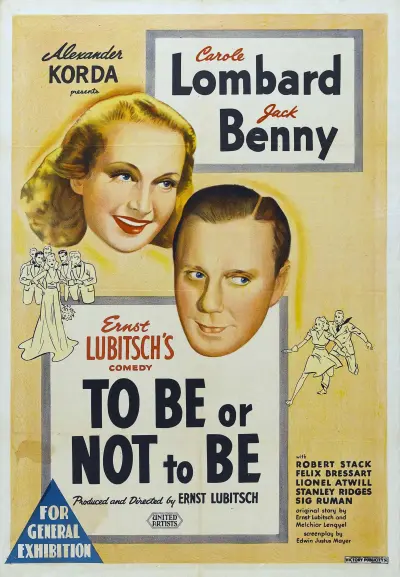
'To Be or Not to Be' is a catchphrase borrowed from Shakespeare that gained new life in Ernst Lubitsch's 1942 black comedy. The film delves into the human condition against the backdrop of World War II, taking us into the lives of a Polish theater troupe led by the conceited yet charming Joseph Tura (played by Jack Benny) and his equally compelling wife, Maria Tura (portrayed by Carole Lombard in her final role before her tragic death in an airplane accident).
The story is set in Warsaw on the eve of the Nazi invasion, as the troupe prepares for a new play satirizing Hitler. However, due to abrupt censorship caused by the volatile political environment, the play is transformed into a performance of 'Hamlet.' The movie finds its first moments of delightful comedy in these performances, featuring Joseph's exaggerated soliloquies and Maria's flirtations with a young pilot named Sobinski (played by Robert Stack). But as the reality of war unfolds and Nazi occupation takes hold, the farce abruptly shifts into a high-stakes spy thriller.
The troupe is forced to use their theatrical skills to outwit the Gestapo, led by the sinisterly polite Colonel Ehrhardt. Lubitsch skillfully balances a light-hearted tone while maintaining the gravity of the war narrative, showcasing his signature "touch." The film weaves intricate themes of identity, performance, and facade in both personal and political contexts, resulting in a series of mistaken identities, close calls, and daring escapades that keep viewers on the edge of their seats.
One of the film's most significant themes is the power of art and performance as a means of resistance. Joseph, Maria, and their compatriots do not possess guns or armies; instead, they harness the power of costumes, accents, and bravado. Their mastery of blurring the lines between reality and performance fools even their enemies, conveying a powerful message about art's ability to challenge tyranny and oppression. In this way, the film challenges the notion that "the pen is mightier than the sword" by suggesting that sometimes, the act itself is mightier than the gun.
Lubitsch also injects a fascinating discourse on heroism into the narrative. While Joseph Tura's on-stage portrayal of Hamlet grapples with the existential dilemma of action versus inaction, off-stage, he finds himself caught in a fight that demands decisive action. This clever parallel allows both Joseph and Sobinski to explore heroism in different ways. Sobinski embodies the straightforward bravery of a soldier, while Joseph's path is more reluctant, comedic, yet ultimately heroic. The story's ironic twist even suggests that the greatest acts of valor can be disguised in the most unlikely forms.
In conclusion, 'To Be or Not to Be' remains an enduring classic due to its sharp wit, thrilling narrative, and layered performances that capture the ethos of an unparalleled time. The film serves not only as a mirror reflecting the absurdity of war but also as a testament to the resilience of the human spirit. Lubitsch's work proves that humor can be a powerful weapon, capable of instilling hope in the darkest of times. The film invites us to reflect on our own masks and the roles we choose or are compelled to play in life's grand theater.

